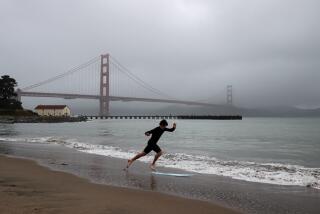Redondo Council Looks Into Ways to Clean Up Pollution Entering Bay : Environment: Study finding human viruses at Herondo Street drain raises concern about runoff and illegal dumping. Public works officials are asked for prevention tactics.
The Redondo Beach City Council asked city officials Tuesday night to develop a plan to help clean up Santa Monica Bay--and the city’s name--both of which were stained by a recent environmental study that found harmful viruses at a local storm drain.
The special meeting called by Mayor Brad Parton was convened to address the study’s new and troublesome finding that the Herondo Street storm drain tested positive for viruses and human feces. The council, however, took no official action, instead directing the city’s Public Works Department to provide it with short-term and long-term strategies for combatting viruses and pollutants.
Though declaring her support for measures to improve the health of Santa Monica Bay, Councilwoman Barbara J. Doerr said the mayor’s concerns seemed motivated more by politics than anything else.
“It’s not new that we have had serious problems in our oceans,” Doerr said. “I think (the meeting is) sort of a joke, Mayor Parton.”
“I had never heard of the whole virus issue (before the study), and that’s why I was concerned,” Parton replied. Parton defeated Doerr and four other Republican candidates in the June primary in his bid for the 53rd state Assembly seat.
The study released last week by the Santa Monica Bay Restoration Project, a publicly funded consortium of environmentalists, government regulators and sewage officials, discovered human enteric, or intestinal, viruses at all three of its sampling sites: Malibu Lagoon, the Pico-Kenter storm drain in Santa Monica and the Herondo Street storm drain in Redondo Beach. Enteric viruses can sometimes cause health problems ranging from stomach flu to dysentery and respiratory difficulties. Researchers believe human feces are responsible for the presence of the enteric viruses.
At the Herondo Street drain, two of five samples tested positive for enteric viruses. Located north of the King Harbor Marina, the Herondo Street drain also funnels runoff into the bay from Torrance and Hermosa Beach. The study reported 55% of more than 500 Los Angeles residents surveyed said they did not swim in the ocean because of pollution concerns.
Public works officials said they were unsure what the source of the viruses could be. During a presentation to the council, Public Works Director Desi Alvarez explained that the feces could be from illegal dumping from holding tanks of recreational vehicles, homeless people or leaking sewer lines.
A long-term measure under study by the city focuses on diverting the flow from the Herondo Street drain and rechanneling it to the Los Angeles County sewage treatment plant in Carson. But Alvarez warned council members that such a diversion, and subsequent treatment costs, can be expensive. Santa Monica spends more than $100,000 annually to divert runoff from the Pico-Kenter storm drain to the Hyperion Treatment Plant, Alvarez said.
Eve Reymond, a Redondo Beach resident and a member of Heal the Bay, said the environmental group regards the Herondo Street storm drain as a major culprit in polluting the bay. Reymond said she supports the diversion of Herondo Street drain runoff to the Carson facility.
Reymond also urged the council to paint warnings in the city’s catch basins, a procedure known as stenciling, to make sure citizens realize that dumping pollutants is illegal.
“People dump pollutants in the catch basins, and they just don’t know it’s against the law,” Reymond said.
More to Read
Sign up for Essential California
The most important California stories and recommendations in your inbox every morning.
You may occasionally receive promotional content from the Los Angeles Times.










